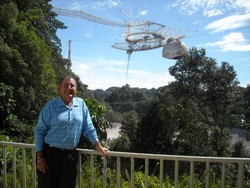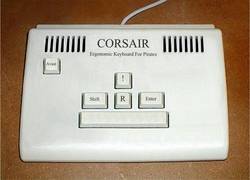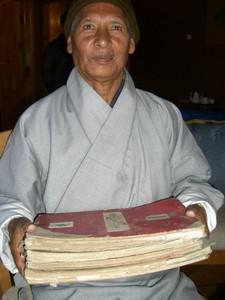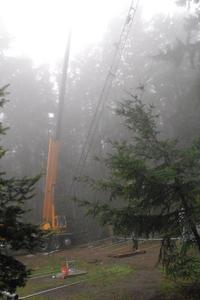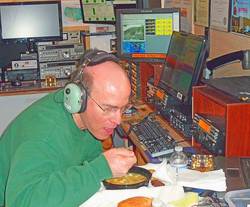 November 9, 2011 Editor: Ward Silver, NØAX | ||||||||
IN THIS ISSUE
NEW HF OPERATORS - THINGS TO DO After a weekend of CQ WW slam dancing followed by the CW Sweepstakes, you could be forgiven for taking a weekend off! But then get those vocal cords ready for Phone Sweepstakes and the CW version of CQ WW. And do make sure you have plenty of envelopes at the QSL bureau! BULLETINS There are no bulletins in this issue. BUSTED QSOS The right name for NO3M is Eric, not Ty. (Thanks, Bill WY3A) CONTEST SUMMARY Complete information for all contests follows the Conversation section Nov 12-13
Nov 19-20
Your editor thoroughly enjoyed making off to KP4 for an incognito adventure in the CW Sweepstakes as NP4DX with ARRL Contest Branch Manager, Sean KX9X. Thanks to local KP4 hams KP4WW, WP3R, and WP3MW for their hospitality and assistance!
Claimed scores in the 2011 CQ Worldwide Phone contest shot through the roof compared to last year. In their many reports on the 3830 score-posting website, operators report terrific openings on the higher bands and many more QSOs at higher rates than in recent memory. The number of submitted logs already exceeds 4000 just a few days after the contest - welcome back sunspots! ARRL Sweepstakes Manager, Larry K5OT observes after encountering a few stations omitting their call signs from the Sweepstakes exchange, according to Sweepstakes rule 4.3 you must include your full call sign in the exchange. Leaving it out throws off the other station's copying rhythm and may cause requests for fills that waste time, plus you lose a "free" CQ for stations tuning by. Make sure your logging software includes the call sign as part of the exchange to be sent and also that the information is sent in the recommended order: number, precedence, call, check, and section. Get your SS CW log submitted and focus on the Phone weekend - there are already more than 750 logs submitted. Send yours in no matter what size...they are all important! The ARRL 10 Meter Contest will be written up starting with the 2011 edition by new author, Scott Tuthill K7ZO. Given the wildly improved conditions, Scott will have plenty to write about after the dust settles in December. Scott is one of the crew at the Oregon super-station of NK7U that is featured in the latest National Contest Journal. Breaking new ground already, Scott is in the final stages of completing a novel "pre-writeup" that will be posted on the contest's ARRL web page in a few days! Icom - the prime plaque sponsor for ARRL Sweepstakes - is also sponsoring a different sort of contest this coming weekend. The first D-STAR QSO Party will run from Nov 11 through the 13th and emphasizes the worldwide connections afforded to handheld users anywhere within range of a D-STAR repeater.
Dave K5GN sent a link to a great story about a 99-year-old ham in Alaska, Arlene "Buddy" Clay KL7OT. She originally moved to Alaska in 1944 with her husband Earl, KL7EM (SK) to be part of the Civil Aviation Authority's communications system. The CAA (predecessor to the FAA) set up teams - usually a husband and wife - to operate radio stations so that pilots could stay in contact with the ground as they flew over uninhabited areas. (Thanks, Dave K5GN) The Contesting Wiki continues to grow and contains a wide source of hints, tips, kinks, and narrative. This is a great resource for those learning about radiosport. For those more experienced in the ways and means of contesting, consider lending some of your expertise to the site, as well! (Thanks, Hans KØHB) Assisted by Amateur Radio, the British APEX team managed to set several ballooning records although the record for altitude remains a bit out of reach. Not quite a ham radio record, but I think we can all enjoy the achievements of other amateur endeavors and hams were right there along the way, helping track the balloon almost all the way to its eastern landing in Poland or Russia. In the realm of sunspots and stocks, no prediction is too flaky not to get some attention so it seems inevitable that a correlation between the two would eventually be proposed. A close look at the data by Robert Ferri finds little of actual merit to the claim but the process of analysis makes for a good read. (Thanks, Mark K6UFO) The latest EDN Ham Radio Today column by Doug K1DG is a good survey of the amateur service for technical folks. You might want to bookmark this page for future reference when someone asks, "Do you still do that?" Web Site of the Week - Could it be cool again to be a hands-on tinkerer? A recent Christian Scientist Monitor article about the "Maker" movement - also known as Do-It-Yourself (DIY) - is attracting a lot of kids to the workbench. Corporate America is noticing, with tools and parts selling well. Ham radio, being intensely hands-on, would seem to be a natural part of the DIY world - if only we can bring ourselves to participate in it! Look for a "Hackerspace" near you - or is that "Shackerspace"? WORD TO THE WISE Here are some various bits of homespun ham wisdom - "QRP - when you care enough to send the very least (W4QO)" Craig K9CT is building what looks to be a spectacular contest station in the fields near Peoria, IL and you can take a tour in this YouTube video shot from a lofty perspective, indeed! You may remember a story about an accidental encounter between a concrete truck and the guy wires for the VHF+ tower but all has been repaired as you can see here. (Thanks, Ken WB9REQ)
A recent story about amateur rocketry garnered lots of attention and the project leader, Derek Deville, has been interviewed about his activities on the Slashdot website. If you think this sounds like high-performance radio, you're not alone! You may have heard HB9STEVE on the air over the weekend, honoring the memory of tech pioneer Steve Jobs. As this Computerworld video shows, Steve has something in common with many hams in his appreciation of Heathkit, discussed about five minutes into the interview. (Thanks, Peter AC7SB) VY1EI put a lot of smiles on Sweepstake operator faces last weekend - you can read all about Eric's experience in his post-contest writeup from the 3830 reflector. It's not all peaches and cream being sought after by a horde of stations! Way to go, Eric! The 3830 archives make great reading, by the way. (Thanks, Steve N2IC)
The question of how speeds are measured in the High-Speed Telegraphy (HST) competitions was recently answered by Barry W2UP. "HST CW speeds are in characters per minute. This differs from both PARIS (which is still used in RUFZ) and WPM...250 CPM is equivalent to 60 WPM letters, 89 WPM figures, and 72 WPM Mixed characters. They differ because all figures are 5 dits/dahs long, while other characters vary in length and an average is used...it's a linear scale and you can extrapolate any other values using the ratios of CPM to WPM above." Dink N7WA has fired up the online Soapbox comment collector for CQ WW and CW Sweepstakes. Valery R5GA has also launched his CQ WW Claimed Scores website with lots of sorting and searching functions - enjoy! OPERATING TIP Keep an eye on that VFO - too many US call signs are heard out-of-band during CQ WW Phone, particularly when working stations operating split on 40 meters! How to get that deeply-buried PL-259 loosened? With so many cables and connectors packed into a station, it can be almost impossible to turn the shell of a PL-259 in the midst of a packed panel. Several readers have contributed ideas but the best I found involve a tool for the purpose. Mike W3MC and Mark N1UK recommend the Knipex "Micro Cobra" style pliers, nylon-jawed if you can find them. Your editor has found that heavy-duty spark plug boot pullers also work and are available at a local auto-parts store. These can turn not only the UHF shells but N, BNC, and even F! Tree N6TR has been fixing his Tailtwister with a new-style brake wedge. He developed this handy how-to guide for other rotator repair-ers.
This isn't a guaranteed engineering solution but if you are considering screw-in guy anchors for a tower and aren't sure which type is the correct type, Mike NF4L suggests asking what the local telephone and electric companies are using to hold up power poles. They will have already done considerable work to assess local soil conditions and selected the right model. If you're tired of chasing the footswitch around under the operating desk, try a switch guard such as this Linemaster model. It holds the switch under your foot and the whole assembly can be moved around for comfort. (Thanks, Steve K6AW) If you live in a location where ice can build up on your guy wires, watch out for melting ice sliding down into the Preform Big Grips - they can be knocked loose by a big enough impact! Dave W6NL suggests placing a small hose clamp around the end of the grip - this prevents the grip from loosening due to an impact. A recent Analog Dialogue article has possibilities in the SDR and test equipment world - the circuitry for a sampling front-end that uses a PC sound card to create a high-speed signal digitizer. By studying how jump ropes bend in the wind, Princeton mechanical engineers Jeffrey Aristoff and Howard Stone also came up with a mathematical model for how antennas and other flexible things are affected by air flow. Now for a double-dutch dipole! Technical Web Site of the Week - Now we know why high-pitched QRM (phone or CW) is more annoying than low-pitch rumbling. A recent story in Science about fingernails on chalkboards (just the words make me cringe) explains that it is the high-pitched tones do the dirty work. If filtered out, the sounds are not nearly as aggravating. Time to reach for that passband shift control! Power Surge It has been a LONG time since we have experienced HF contest conditions like those during the past two weekends of CQ Worldwide Phone and ARRL November CW Sweepstakes. Little Pistols and those of you new to HF - wasn't that fun? Techs, you've doubtless grown weary of the "no meters like 10 meters" nostalgia, surely thinking the pie-eyed old-timers must have been making it up. Well, we may have gotten a little soggy with it at times but now you know why! The long-suffering 10 meter operators at the multi-multi stations must have felt like having been released from the years of silent suffering immersed in receiver hiss and little else.
Looking back through my old logs, 2005 and 2006 were the last years for which there were extended, worldwide openings on 10 meters and the band was clearly in decline by that point in the cycle. 15 held in there for another year but soon HF contesting became a question of who could hold a frequency on 20 meters or stay up all night doing low-band battle. Roaring back to life earlier this year, though, sunspot cycle 24 has pumped adrenaline into contesters and RF into antennas around the globe. If I were an alien outpost monitoring the Earth on HF, I would think the planet is undergoing some kind of euphoric electromagnetic eruption every week or so...well, aren't we? During Worldwide, stations packed the 10 meter band well above 29 MHz with good rate to be had. QSOs were even reported on 10 meter FM - it IS a phone contest, after all! 15 meters and 20 meters were full and busy at the same time. The decision wasn't which band was open but which band offered the highest point value, adding a whole new aspect of strategic challenges. During the CW Sweepstakes, conditions may have been TOO good - with so much activity on 17 and 12 meters, casual stations may have found the smorgasbord of DXing too attractive to stay with just one contest! Combined with the near global ubiquity of spotting networks, the contest environment has suddenly switched from famine to feast as the networks dispense data at dazzling densities that a single-op just can't hope to keep up with. Watching the spots gush down the screen, I felt like I was watching the radiosport equivalent of the Matrix. With so many stations spotted so widely, the difficulty is not going to be pouncing on each spot but deciding which of the spots to ignore. All of the technology that has been deployed in order to acquire and broadcast information on a scarcity of stations now finds itself saturated at its input. How do we manage too much information instead of not enough? Combine that with an SDR-type display and you will be able to hear the neurons frying! As an aside, I noticed a great deal of contest-related chatter on Facebook during the CQ Worldwide weekend. I'm sure there was plenty as well on Twitter and other social sites, including chat rooms and similar ham-focused groups. Remember that contest activity - meaning the communication of call signs and exchange information - is restricted to those six bands from 160 through 10 meters. Your posts shouldn't give the game away by providing information about where you're operating, when you're operating or going to operate, or what information you're handing out on the air. It's unreasonable in today's always-connected world to expect contesters to "go dark" during the competition - post if you must - just make sure the competing goes on "between the lines".
Another thing I've noted is that good conditions have a multiplier effect on activity - along with providing more multipliers, of course. The relationship between sunspot activity and the radiosport BIC Coefficient (Butt In Chair) is quite non-linear. The new ARRL 10 Meter Contest writeup author, Scott Tuthill K7ZO, shows this pretty clearly in his upcoming "pre-writeup" article mentioned earlier. With contacts abundant and attainable by the modest station, more operators find it easy to put in more hours in front of more radios. As the reported record scores attest, good conditions are making it possible to contact many new call signs around the world previously hidden by propagation. For example, the K3LR team logged 30% more contacts than the old multi-multi record by KC1XX from 1999. The blooming of ham radio around the world over the past decade is going to bear significant fruit. So we have more hams on more bands making more contacts from more places - what's not to like? With the possible exception of the low-band specialists, we should all be pumped up about the next few years of great radio action. With all this great equipment and antennas and so many more hams today, we are surely writing the story of the Good New Old Days with each contest. Say, what's that hot smell coming from the ionosphere? Power surge, anyone? 9 November through 22 November An expanded, downloadable version of QST's Contest Corral in PDF format is available. Check the sponsor's Web site for information on operating time restrictions and other instructions. HF CONTESTS Worked All Europe DX Contest--Digital, from Nov 12, 0000Z to Nov 13, 2400Z. Bands (MHz): 3.5-28. Exchange: RST and serial (see web for QTC rules). Logs due: Nov 28. Rules 10-10 Fall Digital QSO Party--Digital, from Nov 12, 0001Z to Nov 13, 2359Z. Bands (MHz): 28. Exchange: Call, name, 10-10 number, S/P/C. Logs due: Nov 28. Rules Japan International DX Contest--Phone, from Nov 12, 0700Z to Nov 13, 1300Z. Bands (MHz): 3.5-28. Exchange: RST and JA prefecture or CQ Zone. Logs due: 30 days. Rules OK-OM DX Contest--CW, from Nov 12, 1200Z to Nov 13, 1200Z. Bands (MHz): 1.8-28. Exchange: RST and serial or OK/OM district. Logs due: Dec 1. Rules Kentucky QSO Party--Phone,CW,Digital, from Nov 12, 1400Z to Nov 13, 0200Z. Bands (MHz): 1.8-28, 50, Frequencies: CW--1.815, 3.550, 7.050, 14.050, 21.050, 28.050, 50.090; SSB--1.855, 3.820, 7.240, 14.280, 21.390, 28.390, 50.190. Exchange: RST and KY county or S/P/C. Logs due: Dec 31. Rules CQ WE (Western Electric)--Phone,CW,Digital, from Nov 12, 1900Z to Nov 14, 0500Z. Bands (MHz): 1.8-28, 50-440. Exchange: Call, name, Bell QTH, yrs of svc (see web). Logs due: Dec 1. Rules SKCC Weekend Sprintathon--CW, from Nov 13, 0000Z to Nov 13, 2359Z. Bands (MHz): 3.5-28. Frequencies: Monthly on the second Sunday. Exchange: RST, S/P/C, name, SKCC nr or "none". Logs due: 5 days. Rules NAQCC Monthly QRP Sprint--CW, from Nov 17, 0130Z to Nov 17, 0330Z. Bands (MHz): 3.5-14. Frequencies: Monthly on 2nd Tuesday or 3rd Wednesday local time (alternating). Exchange: RST, S/P/C, and NAQCC mbr nr or power. Logs due: 4 days. Rules Mongolia DX Contest--Phone,CW, from Nov 19, 0000Z to Nov 20, 2359Z. Bands (MHz): 1.8-28. Exchange: RS(T) and CQ Zone. Logs due: Dec 31. Rules LZ DX Contest--Phone,CW, from Nov 19, 1200Z to Nov 20, 1200Z. Bands (MHz): 3.5-28. Exchange: RST and ITU Zone or LZ district. Logs due: 30 days. Rules Feld-Hell Turkey Shoot Sprint--Digital, from Nov 19, 1600Z to Nov 19, 1800Z. Bands (MHz): 3.5-28. Frequencies: Monthly on 3rd Saturday. Exchange: RST, S/P/C, Feld-Hell member nr. Logs due: 5 days. Rules http://www.feldhellclub.org All Austria 160 Meter Contest--CW, from Nov 19, 1600Z to Nov 20, 0700Z. Bands (MHz): 1.8. Exchange: RST, serial, OE district. Logs due: Dec 31. Rules ARRL November Sweepstakes--Phone, from Nov 19, 2100Z to Nov 21, 0300Z. Bands (MHz): 1.8-28. Exchange: Serial, category, call, check, ARRL sec. Logs due: Dec 6. Rules Collegiate ARC Championship--Phone, from Nov 19, 2100Z to Nov 21, 0300Z. Bands (MHz): 1.8-28. Exchange: See ARRL Sweepstakes. Logs due: Dec 6. Rules RSGB Second 1.8MHz Contest--CW, from Nov 19, 2100Z to Nov 20, 0100Z. Bands (MHz): 1.8. Exchange: RST, serial, UK district. Logs due: Dec 5. Rules Homebrew and Oldtime Contest--CW, from Nov 20, 1300Z to Nov 20, 1700Z. Bands (MHz): 3.5-7. Exchange: RST, serial, and category. Logs due: Dec 20. Rules Run For the Bacon--CW, from Nov 21, 0200Z to Nov 21, 0400Z. Bands (MHz): 1.8-28. Frequencies: Monthly on 3rd Sunday night (local). Exchange: RST, S/P/C, Flying Pig nr or power. Rules VHF+ CONTESTS ARRL EME Contest--Phone,CW,Digital, from Nov 19, 0000Z to Nov 20, 2359Z. Bands (MHz): 50-1296. Exchange: Call signs, sig rpt, acknowledgement. Logs due: Dec 20. Rules Kentucky QSO Party--Phone,CW,Digital, from Nov 12, 1400Z to Nov 13, 0200Z. Bands (MHz): 1.8-28, 50, Frequencies: CW--1.815, 3.550, 7.050, 14.050, 21.050, 28.050, 50.090; SSB--1.855, 3.820, 7.240, 14.280, 21.390, 28.390, 50.190. Exchange: RST and KY county or S/P/C. Logs due: Dec 31. Rules CQ WE (Western Electric)--Phone,CW,Digital, from Nov 12, 1900Z to Nov 14, 0500Z. Bands (MHz): 1.8-28, 50-440. Exchange: Call, name, Bell QTH, yrs of svc (see web). Logs due: Dec 1. Rules LOG DUE DATES 9 November through 22 November
ARRL Information Click here to advertise in this newsletter. Your One-Stop Resource for Amateur Radio News and Information ARRL membership includes QST, Amateur Radio's most popular and informative journal, delivered to your mailbox each month. Subscribe to NCJ - the National Contest Journal. Published bimonthly, features articles by top contesters, letters, hints, statistics, scores, NA Sprint and QSO Parties. Subscribe to QEX - A Forum for Communications Experimenters. Published bimonthly, features technical articles, construction projects, columns and other items of interest to radio amateurs and communications professionals. Free of charge to ARRL members: Subscribe to The ARRL Letter (weekly digest of news and information), the ARES E-Letter (monthly public service and emergency communications news), Division and Section news -- and much more! ARRL offers a wide array of products to enhance your enjoyment of Amateur Radio. Visit the site often for new publications, specials and sales. Donate to the fund of your choice -- support programs not funded by member dues! ACKNOWLEDGEMENTS ARRL Contest Update wishes to acknowledge information from WA7BNM's Contest Calendar and SM3CER's Contest Calendar. | ||||||||

